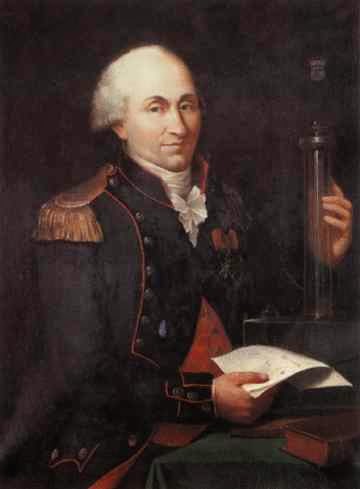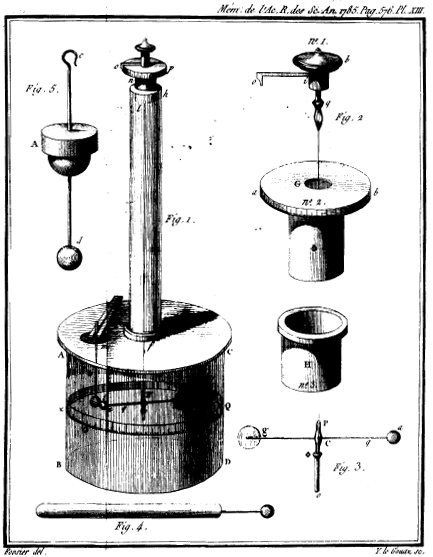
Charles-Augustin de Coulomb (1736 – 1806)
On June 14, 1736, French physicist Charles Augustin de Coulomb was born. He is best known for developing Coulomb’s law, the definition of the electrostatic force of attraction and repulsion, but also did important work on friction. The SI unit of electric charge, the coulomb, was named after him.
Charles Augustin de Coulomb – Early Years
Charles Augustin de Coulomb received a good education in mathematics, astronomy, chemistry and botany since both sides of his family were respected and quite wealthy which allowed Coulomb to be raised as a child of privilege. He went to school in the Collège Mazarin in Paris, but, after his father had made some poor decisions, the family faced financial difficulties and Coulomb moved along with his father to Montpelier, where he joined the Academy of Sciences and managed to present several papers, focusing mostly on topics in astronomy and mathematics. He began studying there in early 1760 and graduated at the end of 1761, beginning his career in government service as a lieutenant in the Corps de Génie, where Coulomb performed tasks as a civil engineer, for example in the repair of fortifications. He was initially stationed in Brest and from 1764 in Martinique in the Caribbean, which had been temporarily conquered by the English in 1762 and was to be more strongly fortified after being returned by France. Until 1772, Coulomb directed the construction of the new Fort Bourbon. The fruit of this work was also a treatise on structural analysis, which he published in the treatises of the French Academy of Sciences (Académie des sciences) in 1773 after his return to France, and which brought him to the attention of scientists such as his former teacher Charles Bossut.
Engineering and Mechanics
Coloumb began to focus more and more in engineering and mechanics, which provided him with a firm foundation on which his later theoretical efforts were built. He submitted his first treatise to the Academy of Sciences in Paris in 1773, and many more would follow on topics ranging from mathematical solutions of engineering problems to studies of friction, elasticity, electricity and magnetism. While stationed in Cherbourg, Coulomb wrote a treatise on the compass that won him a prize from the Paris Academy in 1777. The treatise was also significant because it dealt with the torsion balance (and, in general, the torsion of thin threads), which would later become the basis of his experiments to measure even weak forces. After a visit to Rochefort in the late 1770s, Coloumb was promoted to a Captain and employed at La Rochelle, the Isle of Aix and Cherbourg. In this period, Coulomb discussed his experiments with electrostatic forces and explained the inverse square law that they led Coulomb to posit.

Coulomb electric balance, torsion balance
The Inverse Square Law
Similar to Isaac Newton’s inverse square law of gravitational force, Coulomb’s law states that the electric force between charged objects inversely depends upon the distance between the objects. That is, like gravity, the electric force acts in a line between two objects and decreases with the square of the distance between them. The primary difference between the law for gravity and that for electric force is that gravitation is influenced by the mass of the objects, whereas Coulomb’s law depends upon the charge of the objects involved. When the objects in question are both positively or both negatively charged, the forces between them are repulsive, but attractive forces arise between objects carrying opposing charges [1].
A Wooden Fortress
In 1779, he was sent to Rochefort to help the Marquis de Montalembert, who was pursuing new ideas in fortress construction that deviated from the classical line of Vauban,[9] to build a fort entirely of wood. At the Rochefort shipyards, he conducted experiments that led to his treatise Theorie des machines simples, in which he developed his theory of frictional forces. It earned him the Grand Prize of the Paris Academy of Sciences in 1781 and led to his admission to the Academy, which made Coulomb independent.
Later Years
After the outbreak of the French Revolution in 1789, Coulomb lost or resigned many of his posts. In 1791 he left the Corps de Genie. After the Academy of Sciences was dissolved in 1793, he retired to the countryside in Blois, where he owned a house and continued his experiments. It was not until 1795 that he returned to Paris with the founding of the Institut de France, which replaced the Academy, and his election as a member of the Institute. Napoleon brought him back into the civil service from 1802 to 1806 as supervisor of the country’s education system, promoting the establishment of new grammar schools (Lycée) throughout France. Charles-Augustin de Coulomb passed away on August 23, 1806.
Walter Lewin, 8.02x – Lect 1 – Electric Charges and Forces – Coulomb’s Law – Polarization, [11]
References and Further Reading:
- [1] Charles Augustin de Coulomb at the University of Florida
- [2] Charles Augustin de Coulomb at the University of St Andrews
- [3] André Marie Ampére and Electromagnetism, SciHi Blog
- [4] John J. O’Connor, Edmund F. Robertson: Charles Augustin de Coulomb. In: MacTutor History of Mathematics archive
- [5] Chisholm, Hugh, ed. (1911). “Coulomb, Charles Augustin“. Encyclopædia Britannica. 7 (11th ed.). Cambridge University Press.
- [6] Works by or about Charles-Augustin de Coulomb at Internet Archive
- [7] Charles Augustin de Coulomb, Théorie des machines simples (1821)
- [8] Charles Augustin de Coulomb, Collection de mémoires relatifs à la physique (1884)
- [9] Vauban or the Art of Fortress Construction, SciHi Blog
- [10] Charles Augustin de Coulomb at Wikidata
- [11] Walter Lewin, 8.02x – Lect 1 – Electric Charges and Forces – Coulomb’s Law – Polarization, Lectures by Walter Lewin. They will make you ♥ Physics. @ youtube
- [12] Timeline of French physicists, via Wikidata and DBpedia






Pingback: Whewell’s Gazette: Year 3, Vol. #44 | Whewell's Ghost